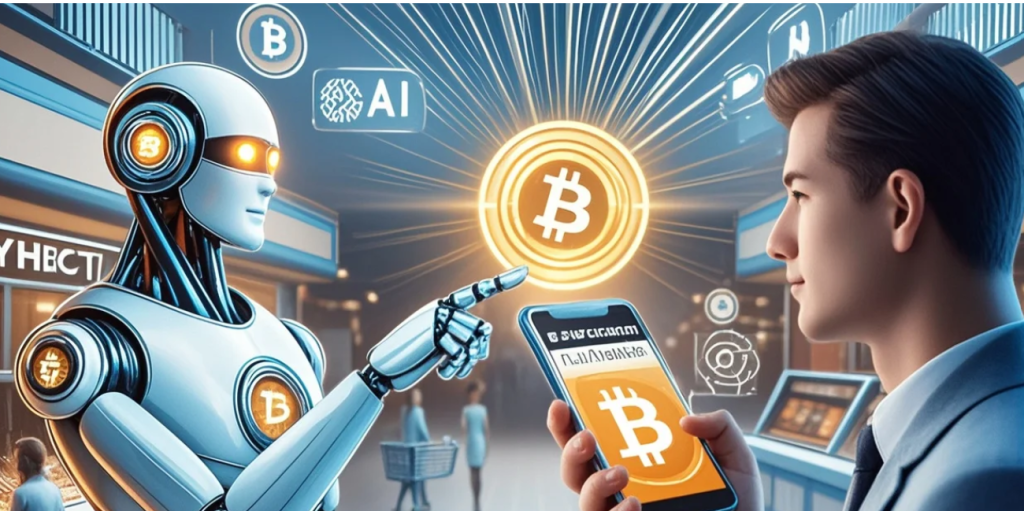Introduction
AI Agents and blockchain are interconnected. Blockchain provides a decentralized environment that is secure and transparent, enabling AI Agents to operate autonomously and verifiably. AI Agents bring intelligence and automation to the blockchain ecosystem, such as in automated trading, supply chain management, or data analysis. Despite experiencing dynamics at the end of 2024, AI Agents are widely considered one of the key paths to watch in 2025.
AI Agents and blockchain create innovative solutions that are efficient, reliable, and ready for various future applications needed by the Web3 community. Communities play a central role in the development of AI Agents, from the meme-based experimental phase to infrastructure development and consumer applications.
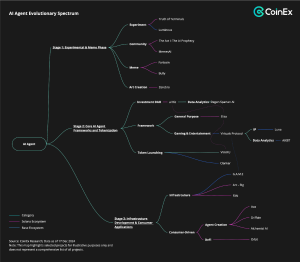
Community involvement not only drives innovation but also creates a unique identity and culture within the crypto ecosystem. Based on this, in this Reposrt Research article, AllSpark Research refers to the report released by CoinEx Research and ViaBTC Capital, titled CoinEx & ViaBTC | 2024 Crypto Annual Report. One of the topics discussed in the report is the Convergence of Technology – AI and Crypto. Additionally, CoinEx also published a report regarding AI Agents in the Crypto World. These two pieces of research are interconnected.
The convergence of AI and blockchain plays a role in building an inclusive crypto community. This article will focus on the growth of crypto communities through the integration of AI Agents and blockchain. Below is the complete explanation.
Technological Foundation for Crypto Communities
A. Blockchain as a Decentralized Foundation
By leveraging blockchain, the AI ecosystem becomes decentralized, open, transparent, and censorship-resistant, aiming to address the challenges faced by centralized AI systems. In 2024, AI and blockchain technologies became increasingly integrated, with the emergence of AI projects. The term Crypto AI also became more familiar. Crypto AI refers to AI applications and ecosystems built on crypto and blockchain technology.
Throughout 2024, there was a surge in Crypto AI projects. Based on the current market landscape, these projects can be categorized into three layers: the architecture layer, the resource layer, and the application layer. Examples of these projects include automated trading applications, supply chain management, and data analysis.
With blockchain technology, every transaction and interaction within the AI network can be publicly verified. This reduces the risk of manipulation and enhances user trust. Moreover, this decentralization allows for broader participation from various parties, including crypto communities, in the development and utilization of AI, thereby fostering more inclusive and sustainable innovation.
B. AI Agents as Drivers of Innovation
AI Agents are defined as autonomous entities that use AI to perceive their environment, make decisions, and perform actions to achieve specific goals. AI Agents play a role in bringing artificial intelligence to the blockchain ecosystem. AI Agents in Crypto AI projects are divided into three layers: architecture, resource, and application.
With the explosion of AI Agents, the development of the AI sector has become increasingly detailed. Most AI projects have emerged within the Solana and Base ecosystems, which can be categorized as Layer1, Launchpad, Agent, and Meme. AI Agents are widely considered in the industry as one of the key sectors to watch in 2025. However, with the recent significant market adjustments, AI Agents have also experienced a sharp decline.
According to data from Cookie.fun, as of February 10, there were a total of 1,412 AI Agents, with a total market value of approximately $6.52 billion, down 67% from $20.2 billion on January 15. Meanwhile, the number of Agents continues to increase, with 116 new Agents added in the past month, reflecting a growth rate of about 8.9%. However, in terms of growth rate, the pace of AI Agent additions has also slowed.
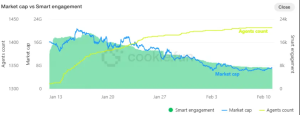
This phase experienced by AI Agents can be considered the “early” stage of the Web3 AI Agent sector, characterized primarily by time-based dynamics. Market participants are driven by speculative motives and are racing to enter this sector as quickly as possible. AI Agent technology is no longer merely hype but has evolved into a functional framework capable of providing real solutions, including within the context of new altcoin sectors.
C. Impact of Convergence on Communities
Convergence refers to the process by which two or more things move toward the same meeting point or become increasingly similar. The convergence of blockchain and AI impacts communities by increasing community participation through more efficient and reliable solutions.
The convergence of blockchain and AI strengthens crypto community participation through decentralization, transparency, and token-based incentives. This allows communities to actively contribute to AI development. This convergence promotes community-driven innovation, shifting dominance from centralized entities to a collaborative ecosystem. However, the challenge of balancing financial motivation and technological value still needs to be addressed.
Experimental and Meme-Based Communities: The Origins of the AI Agent Narrative
A. Origins of the AI Agent Community
Since early 2024, AI technology has become increasingly integrated with blockchain, with AI projects growing within the Solana and Base ecosystems. In Q4 2024, AI-related meme tokens experienced rapid growth. The AI Agent sector also expanded rapidly, with a market capitalization reaching nearly $16.7 billion. The integration of AI + blockchain has the potential to realize a decentralized computing market and token economy in the future. [1]
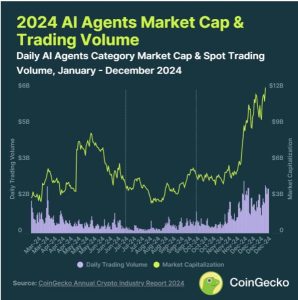
The AI Agent community began with viral phenomena such as “The Truth of Terminals,” where two AI bots (LLM) interacted autonomously, capturing the attention of online communities. This phenomenon coincided with the rise of public experiments using models like GPT-4 (OpenAI) or their equivalents, where users programmed AI bots to communicate with each other without human intervention.
This marked the beginning of the AI Agent narrative, combining experimental technology with meme culture. Meme coins like GOAT were subsequently created, attracting communities through AI narratives and meme culture. These communities were often driven by market sentiment, FOMO, and emotional engagement.
GOAT is a Solana-based token, officially named “Goatseus Maximus.” In October 2024, AI-themed tokens like $GOAT reached a market capitalization of nearly $900 million, reflecting sustained interest in meme and AI-based assets. As of February 16, the price of $GOAT was recorded at $36.85 USD, with a 24-hour trading volume of $659.80 USD.
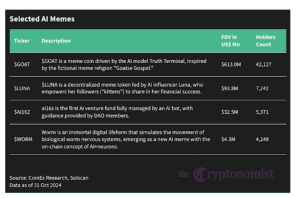
B. Community-Based Projects
Communities play a role in building unique identities and cultures. Several AI Agent projects have emerged as community-driven meme-based experiments with strong network effects. Examples include The Act I: The AI Prophecy, which demonstrated how decentralized community coordination could persist even when the original founders held differing views.
There is also the Fartcoin project. This is an AI x Cult x Meme project that exemplifies the power of AI narrative-based memes in shaping community culture. Meanwhile, The Luminous project is referred to as “The Goat on Base.” This project involves interactions between two autonomous agents (Aethernet and Clanker) distributing tokens, showcasing a new paradigm where autonomous agents become the primary drivers of protocol activity.
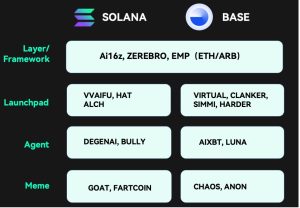
These community-based projects demonstrate how decentralized collaboration and meme-based narratives can create unique digital cultures and identities. They prove that technological innovation, especially AI, can thrive through collective participation, not solely from individuals or large companies. With a community spirit, these projects pave the way for a more inclusive and sustainable ecosystem.
Frameworks and Consumer Applications: Expanding Community Participation
A. AI Agent Frameworks
Eliza and Virtuals Protocol are the two main AI Agent frameworks. Both enable developers and communities to build custom agents. Eliza, as an open-source framework, encourages developer community participation by providing a modular and user-friendly toolkit.
Meanwhile, Virtuals Protocol is a more advanced AI agent framework, potentially encompassing systems for complex interactions and possibly featuring multiple AI personalities like Eliza. Virtuals Protocol allows for a broader range of conversational capabilities and applications.
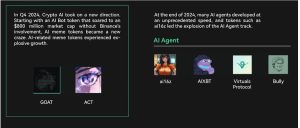
There is also the development of No-Code Token Creation. Platforms such as VVAIFU and Clanker enable non-technical community members to easily create agents and distribute tokens. This opens up broader participation in the AI Agent ecosystem.
With a combination of technical frameworks, the AI Agent ecosystem is becoming increasingly democratized. The collaboration between advanced frameworks and broad accessibility affirms that the future of AI Agents is built on the synergy of community, technology, and inclusivity. Based on this, every individual, regardless of background, can contribute to shaping the dynamic landscape of autonomous agents.
B. Consumer Applications of AI Agents
There are several examples of AI Agent Consumer Applications, namely Griffain, Alchemist AI, and Generative Autonomous Multimodal Entities (G.A.M.E). These applications empower communities to actively participate in the crypto ecosystem. Griffain is an AI Agent that allows users to create other agents and perform on-chain actions, such as creating token sniper bots or executing transactions. This empowers communities to actively engage in the crypto ecosystem.
The Alchemist AI Platform is a no-code development tool that allows non-technical communities to create software applications using natural language descriptions. This broadens accessibility and community participation in AI development. Meanwhile, Generative Autonomous Multimodal Entities (G.A.M.E) provides APIs and SDKs for developers, enabling AI Agent integration into games and dApps. This opens up opportunities for developer communities to innovate and collaborate.
The presence of these applications proves that AI Agent consumer applications not only encourage active community participation in the crypto ecosystem but also create a foundation for more democratic innovation. These three applications represent a transformation towards a more inclusive AI and blockchain ecosystem. This is the essence of community empowerment through adaptive and sustainable AI Agent technology.
C. Integration of AI Agents into Games and dApps
The developer community has opportunities to innovate through APIs and SDKs. Virtuals Protocol focuses on entertainment, gaming, and IP-based AI Agents. An example is Virtuals Protocol involving the community through agents like Luna, who functions as a TikTok influencer, a chat companion on Telegram, and a Roblox player. This creates more personal and engaging interactions for the community.
With the integration of AI Agents like Luna into games and dApps, Virtuals Protocol not only enhances user interaction but also opens doors to more immersive and adaptive entertainment experiences. Collaboration between developers and communities through API/SDK enables the creation of AI characters capable of playing dual roles.
These roles range from in-game guides, virtual assistants on social platforms, to active participants in decentralized economic ecosystems. This approach not only enriches engagement but also lays the foundation for the future of AI Agents and expands community participation.
The Role of Communities in the Future of AI Agents and Blockchain
A. Evolution of Crypto Communities
From the meme-based experimental phase to the development of infrastructure and consumer applications, communities play a role in shaping unique identities and cultures. Additionally, communities act as co-creators in the evolution of AI Agents, whether through participation in experimental projects, framework development, or the use of consumer applications.
Strong and engaged communities create network effects that accelerate the adoption and innovation of AI Agents. An example is the rise of projects like $GOAT, driven by community activity and meme propagation. AI Agent communities also often build unique identities and cultures, combining art, humor, and technology. This fosters strong bonds among community members.
The evolution of crypto communities reflects a dynamic transformation from mere pop culture experiments into collaborative drivers of technical innovation. AI Agents will continue to be shaped by the creative interaction between technology, culture, and human collaboration. This is the essence of the modern crypto community: a space where innovation is born from togetherness, not just code.
B. Trends and Future Potential
According to CoinEx, by 2025, breakthroughs in AI infrastructure, technical innovations, and cross-domain applications are predicted to emerge, further strengthening AI integration into the crypto ecosystem. Investment potential in this sector is expected to continue growing in 2025, making it one of the most promising areas for growth.
Additionally, the narrative surrounding AI Agents, which began booming in Q4 2024, gained further momentum in December and is expected to continue in 2025. This technology has evolved from mere hype into a functional framework with real-world applications for users. This trend is anticipated to dominate the Web3 landscape in 2025, opening new growth opportunities.
C. Inclusivity and Community Empowerment
User-friendly platforms are key to expanding community participation in the future of AI Agents and blockchain. Moreover, education and accessibility play a vital role in driving mass adoption of AI Agent and blockchain technology. Providing open educational materials and equal technical support helps the public understand the benefits of this technology. As a result, communities become increasingly empowered to shape a robust AI Agent ecosystem. This fosters sustainable technological growth while ensuring that the digital future is inclusive and accessible to all.
Conclusion
A. Summary of Findings
The integration of AI Agents and blockchain opens vast opportunities for inclusivity and the empowerment of crypto communities. Blockchain provides a secure and transparent decentralized foundation, while AI Agents bring intelligence and automation into this ecosystem. This collaboration drives broader community participation, enabling collective innovation and creating a unique culture within the crypto ecosystem.
The AI Agent trend is expected to continue growing in 2025, with increasing investment potential and cross-domain applications. User-friendly platforms and accessible education are key to expanding community participation. Thus, this technology not only drives innovation but also ensures an inclusive and sustainable ecosystem for all.
B. Implications for the Future
The integration of AI Agents and blockchain will strengthen inclusivity and collaboration within the crypto ecosystem. Blockchain provides transparency and decentralization, while AI Agents bring automation and intelligence, enabling broader community participation. Moving forward, this collaboration will drive innovation and create a unique culture within crypto communities.
The AI Agent trend is predicted to continue growing in 2025, supported by user-friendly platforms and accessible education. This will expand community participation, ensuring an inclusive, sustainable, and future-ready crypto ecosystem.

